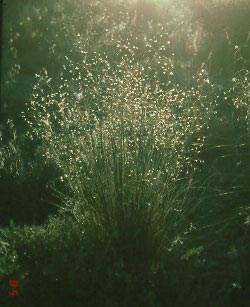Indian Ricegrass

Common Name(s):
Indian Ricegrass
Scientific Name:
Achnatherum hymenoids (Roemer &) J.A. Shultes Barkworth
Scientific Name Synonyms:
Stipa hymenoides Roemer & J.S. Shultes
Oryzopsis hymenoides (Roemer & J.S. Shultes) Ricker ex Piper
Symbol:
ACHY
Description:
Life Span: Perennial
Origin: Native
Season: Cool
Growth Characteristics:
Erect bunchgrass, without rhizomes, growing 1 to 2 ½ feet tall. Starts growth in early spring, flowers in late spring, reproduces from seeds and tillers.
Seedhead:Loose panicle with hair-like branches which spread at distinctly wide angels; spikelets contain one floret, solitary at ends of the panicle branches; lemmas hard and black, remain around the seed, surrounded by dense white hair; awn 3/16 inch, readily breaks off; seeds readily shatter, leaving glumes attached to panicle branches.
Leaves: Numerous, mostly basal, blades slender, rolled, often as long as the culms; sheaths fringed on one margin only; leaves rolled in the bud; ligules up to 3/8 inch long, membranous, pointed, sometimes split; auricle absent.
Ecological Adaptions:
Indian ricegrass is one of the more widely adapted native grasses of Utah rangelands. It is drought tolerant and found on most of Utah's range sites. It grows at elevations between 3,000 and 10,000 feet.
Soils: Adapted to a wide variety of soils, but does not do well on wet or poorly drained soils. It is dominant on sandy stony, gravelly, and shallow soils in the upland and semi-desert climatic zones. It is also adapted to soils high in lime. It is moderately salt and alkali tolerant.
Associated Species: Includes a tremendous variety of range plants from the salt desert shrub association through the foothills bunchgrass, sagebrush types and up into the mountain shrub types.
Uses and Management:
Indian ricegrass is a key species on Utah foothills and semi-desert range. It is one of the more valuable grasses for domestic livestock and big game animals, providing excellent forage for spring and summer use. It is especially valuable for winter grazing because the plants cure well and lower plant parts remain somewhat green. Due to the abundance of plump, nutritious seed, it is an excellent food source for upland game birds, particularly mourning doves, pheasants and others.
Indian ricegrass depends on the moisture of the early growing season to complete its normal growth and food storage cycles. Accordingly, the grazing system for this grass should include an occasional deferment from grazing during the springtime to permit the plant to go through the flower and seed formation stages before available moisture is exhausted from the soil. When grazed during the growing season, 40 percent of the top growth can be safely removed. During the dormant season, 60 percent of the growth can be removed.
Fires that occur in the spring and summer may damage Indian ricegrass.
Seeds are high in protein, and members of various Indian tribes used them to make flour.
Indian ricegrass is the State Grass of Utah.

